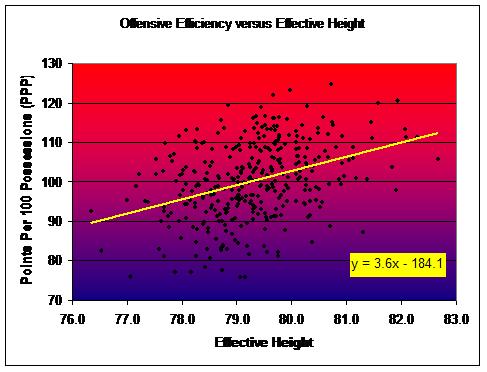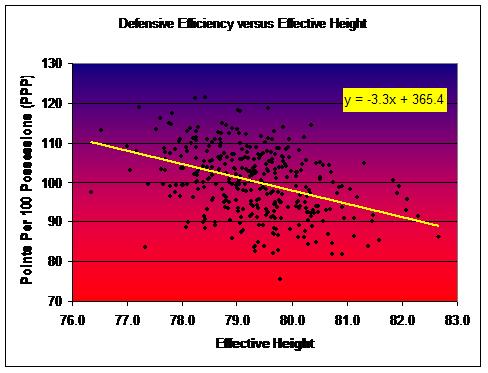Brackets, Braces & Parentheses – Part 1
Posted by rtmsf on December 23rd, 2009Because sometimes, playing with the numbers is more fun than watching the actual games. This is the first of a three-part series on height and college basketball.
“You can’t teach height.” – Frank Layden, Utah Jazz Basketball Coach
More so than in any other sport, height plays a huge role in determining a player’s fate on the court. My wife’s jaw drops when I tell her I’m the same height as Steve Nash. However, as a friend once told me, “being tall does not necessarily correlate with ability to play basketball.” For example, growing up in Charlottesville, the late nineties saw a man by the name of Chase Metheny suit up for the Cavaliers. Chase was an astonishing 7 feet 4 inches tall and he was… terrible. He just didn’t have the body coordination necessary to compete with other bigs in the conference and proving the point that being tall doesn’t mean you can dominate everyone.
So, then, what does it buy you? How does being taller help the average college basketball team?
Ken Pomeroy looked at this last year, but I’d like to take it a bit further. I’ve gone to kenpom.com (where else?) and downloaded the statistics for the effective height of each team. A team’s effective height is the sum of the height of each player on the team weighted by the percentage of minutes played (assuming the player has played at least 10% of the teams minutes). Thus, a team’s effective height can change depending on who they put on the floor. If Texas gives Dexter Pittman (6’10) more minutes relative to Dogus Balbay (6’1), they become a taller team in effective height terms.
I’ve separated the data out into offensive and defensive efficiency and plotted it versus effective height. (Note that redder is better.)


A couple of obvious points pop out immediately. First, there is a clear, positive effect of height on offense and defense; taller teams are much more efficient at putting the ball into and also protecting the basket. For every additional inch of effective height, teams will score 3.6 more points per 100 possessions (PPP) and keep opponents from scoring 3.3 more PPP. This means that you’re getting about 7 PPP more for each additional inch of effective height. That’s a pretty big difference. In efficiency margin terms, it’s like the difference between Kansas (efficiency margin = 42) and Ohio State (35).
Second, as noted by Pomeroy last year, the correlation of effective height with defense is much stronger than the correlation with offense. The dispersion of the defensive efficiency distribution is much lower.
Finally, it should be noted that the correlation isn’t 1:1. There are some short teams that can score. Marquette is a good example; despite not having anyone above 6’7 playing significant minutes and being the shortest team in a major conference, the Golden Eagles can fill it up. Lazar Hayward shoots, a lot, but he also goes to the line a ton, making him an effective scorer.
Some short teams can defend, too. I’d like to point out Army, who is 9-2 and has great defensive stats (90 PPP) in spite of an effective height of 77.1 inches, but their schedule is just awful. Instead, I’m going to go with Duquesne. With the exception of IUPUI, they have respectable losses and yet are only 78.1 inches in effective height, primarily because point guard Eric Evans (5’11) logs so many minutes (79%)
Next Time: Tallest conferences and what happens when two teams of similar height match up.










































